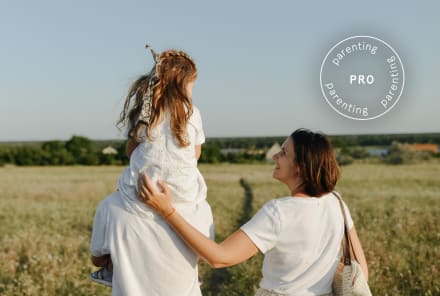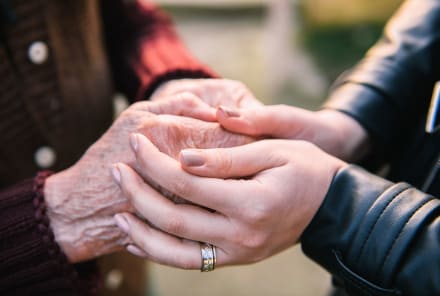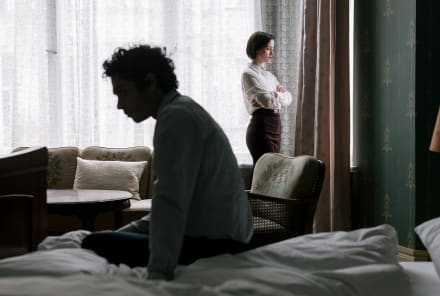Advertisement

The stats around the loss of a child make me shudder—especially since I'm counted among them. One in five pregnancies ends in pregnancy loss. One in 160 ends in stillbirth. Thousands of children die in their first year of life because of SIDS (sudden infant death syndrome). When the unimaginable happens, what do we do? How do we respond? They journey of life after loss is not as clear-cut as our society would have us believe.
It was my second pregnancy and I was blissfully naïve—and confident; I had already given birth to one healthy child. Around the 25-week mark, an ultrasound discovered something that should not have been there. A large tumor encircled my baby's heart like a string. It was tied so tightly that my unborn child's heart was failing and there was nothing the doctors could do. My son, whom we named Zachary, was born at 30 weeks' gestation, and died in my arms, skin to skin, heart to heart, just moments later.
I felt like my body had failed my baby in the one thing it should innately know how to do. When I left the hospital with empty arms, the sharp edge of isolation became my companion. I felt that no one could possibly understand how my heart was being torn in two. I was alone in my grief—until I chose to tell my story.
When I began talking with others about what I'd been through—what I was still going through despite societal expectations of the grief timeline—I began to realize that so many women carry this sorrow inside themselves. Sharing stories between friends, and even strangers, helped me find support. As an artist and writer, I began to express my own personal journey through creative storytelling. I learned that the arts are an incredible tool that can help set us free when we feel hopelessly tangled in grief.
Here are five creative ways to help heal the mother's heart through art:
1. Take stock of your loss through collage.
When a child dies, the loss is devastating—and there are a plethora of secondary losses that also need to be acknowledged. Those could include the size of your family, your ability to have more children, and of course the future you would have had with that child. Collage is a beautiful exercise in editing. It connects us with ourselves through this selective process.
As we make decisions about what images and words to cut out of magazines and newspapers, we begin to see our true grief take shape, a step that often precedes the relief of healing we crave. What images speak to you? Do those visuals include smiling families? Or lonely mountains? Are you cutting out blues and greens or reds and blacks? This editing process, and the reflection at the end, gives us mental space to take stock of all we've been through.
2. Find your healing vocabulary through poetry.
Poetry may grow out of collage-making as you collect words that resonate with you. Writing poetry causes us to find the right word. It forces us to be in the moment and discover what we are really thinking and feeling. Where I may write that I am "mad at life" as I scribble out my thoughts in my journal; when I pause and ponder, maybe something else describes my grief more aptly. Maybe what I am actually feeling is "powerless" that I could not save my child. Or the emotions of being "deeply discouraged" or "outraged" that this happened to me and my family.
Poetry is helpful to express our sadness, but it can also empower us in the pursuit of healing and joy. With the objective of finding the most descriptive and concise way to express ourselves, we can uncover a whole new vocabulary. The words and phrases that continue to bubble up for me after my loss are "deep joy," "whole," and "free." Now, in my daily mantras, I tell myself, "Be free," and ask, "Who controls your joy?" These words and phrases give me the strength to focus on what is within my power, right here, right now.
3. Play like a child through sculpture.
No one teaches us to play when we are kids. Creativity and touch are our first language of communication. We put our hands on our parents, on our food and try to squish, taste, and effect change on the world around us. This is how we learn. Play is a joyful act. It makes us smile. We laugh. We get messy and don't care.
Even as adults, we can tap into the healing energy of play. One of the easiest ways to do this is through making sculpture. You can use clay or even Play-Doh. Roll the clay in your hands; feel it warm up. Make a dinosaur. Or a flower. Or a footprint. Make something ugly and then squish it. Reflect on the fact that it's OK to make mistakes, it's OK to be imperfect and broken. Make something new and take joy in the playfulness of the moment. Having fun while still grieving for your child can be both healthy and celebratory.
4. Practice mindfulness through photography.
Instead of being snap-happy, taking a multitude of photographs quickly, try the opposite. Pause from the hectic pace of life, and from your mind racing through the tunnels of grief, and just be. Before raising your camera (or phone), really look at what you want to take a picture of. Observe it deeply with your eyes first, and take a series of deep breaths. When you hold your lens up to capture the image, think about how you want the picture to look. Will the composition be better if you take a step closer or two back? If you wait just one more minute, will the sun break through the clouds and give you the most gorgeous light?
This is how to find mindfulness through photography. And when we apply this to our healing journeys, we can begin to be more patient and kind with ourselves. We can see that our experiences may be viewed at different angles. When we look at what we have been through with judgment-free, observant eyes, we may begin to feel acceptance, peace, and gratitude. Then we can capture the true essence of our brief encounters with our children and carry those with us as we trek onward in life.
5. Reclaim your joy through dance.
If you're not a dancer, that's OK. Close the curtains and rock it out on your own. It really doesn't matter what you look like. I'll often turn on my favorite music and, like I mentioned before, simply "be free." There is something near magical that happens when we get our bodies moving. Our heart rates rise, the lyrics find their way to our tongues, and we work up a sweat. Often, we end up feeling more alive than we have in days (and for some of us, much longer).
After losing a child, it is easy to get stuck in our heads; feeling depressed, replaying events, and worrying about the future. When we dance, we get off the mental roller coaster and into our bodies instead. The blood starts flowing. We move to the rhythm. We feel the music. There is joy and freedom and love to be found in that place. When we are creative with whatever we have at hand, coping, and eventually thriving again, after loss is within our reach.
Watch Next
Enjoy some of our favorite clips from classes
Enjoy some of our favorite clips from classes
What Is Meditation?
Mindfulness/Spirituality | Light Watkins
Box Breathing
Mindfulness/Spirituality | Gwen Dittmar
What Breathwork Can Address
Mindfulness/Spirituality | Gwen Dittmar
The 8 Limbs of Yoga - What is Asana?
Yoga | Caley Alyssa
Two Standing Postures to Open Up Tight Hips
Yoga | Caley Alyssa
How Plants Can Optimize Athletic Performance
Nutrition | Rich Roll
What to Eat Before a Workout
Nutrition | Rich Roll
How Ayurveda Helps Us Navigate Modern Life
Nutrition | Sahara Rose
Messages About Love & Relationships
Love & Relationships | Esther Perel
Love Languages
Love & Relationships | Esther Perel
What Is Meditation?
Box Breathing
What Breathwork Can Address
The 8 Limbs of Yoga - What is Asana?
Two Standing Postures to Open Up Tight Hips
How Plants Can Optimize Athletic Performance
What to Eat Before a Workout
How Ayurveda Helps Us Navigate Modern Life
Messages About Love & Relationships
Love Languages
Advertisement

The 4 Pillars That Lead To Long-Lasting Relationships, From A Marriage Counselor
Rachel Glik, Ed.D., LPC

The 4 Pillars That Lead To Long-Lasting Relationships, From A Marriage Counselor
Rachel Glik, Ed.D., LPC
















